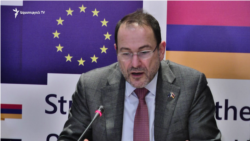The European Union is in no rush to lift its visa requirements for Armenia’s citizens because of a large number of Armenians seeking asylum in EU member states, a senior official from Brussels said on Tuesday.
EU leaders pledged to start a “visa liberalization dialogue” with Yerevan at their Eastern Partnership summit with Armenia and five other former Soviet republics held in Brussels two years ago. The pledge followed the signing of a Comprehensive and Enhanced Partnership Agreement (CEPA) between the EU and Armenia.
Both the current and former Armenian governments have since pressed the 28-nation bloc to set a date for the start of official negotiations on visa liberalization.
Luc Devigne, a deputy managing director at the European External Action Service, indicated that the EU has not yet opened such talks because thousands of Armenians overstay their Schengen visas and seek asylum in Europe.
“This is not a political issue. This is a working issue,” Devigne told reporters in Yerevan.
“I’m pretty sure that when the conditions are fulfilled, when there are no problems of overstaying [EU visas] or asylum seekers, the decision will be positive,” he said.
According to Armenia’s Deputy Foreign Minister Avet Adonts, Yerevan has been discussing the matter with various EU member states in an effort to address their concerns.
“We are trying to understand problems with visa liberalization, if there are such problems, and to jointly find mechanisms and tools for solving them,” Adonts said at a joint news conference with Devigne dedicated to the second anniversary of the signing of the CEPA.
In Devigne’s words, one such solution is closer cooperation between Armenian and EU immigration authorities.
Tens of thousands of Armenians have emigrated to Europe for mainly economic reasons since the early 1990s.
Prime Minister Nikol Pashinian stated in September that number of Armenian asylum seekers there has fallen considerably since last year’s “Velvet Revolution” that brought him to power.
He cited official EU statistics showing that there were 1,815 first-time Armenian asylum applicants in the EU in the first half of this year, down from from 2,475 in the same period of 2018. The number of such asylum seeks stood at 3,250 in the first half of 2017.
“This is one of the most important indicators characterizing the New Armenia,” Pashinian wrote on his Facebook page.
Armenia and the EU signed in 2013 an agreement on “readmission” of illegal immigrants shortly after the EU eased some of its stringent visa rules and procedures for Armenians. Armenia unilaterally abolished its visa regime for the citizens of the EU member states around that time.


Facebook Forum